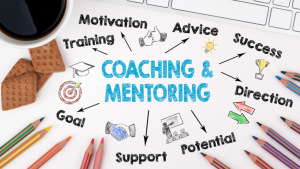
No one likes to hear negative feedback about themselves. It feels demotivating. But negative feedback can turn into a positive experience when you listen to learn and improve your productivity.
When you welcome all types of feedback, you will get promoted faster, make more money, and be on the fast track for new opportunities. It also builds stronger relationships with team members, management, and customers.
9 Tips to Turn ALL Feedback into Success
1. Listen with Intention. If you listen with the intention of learning, you will keep your mind open to hearing what is said. The key is to avoid debating who’s right and who’s wrong; instead, ask clarifying questions.
2. Let Go of the Past! When you hang on to negative feedback, you will get stuck. Immediately after receiving negative feedback, talk with your executive coach and/or mentor to turn negative feedback into a positive learning experience. Then, create a plan of action and take the first step within 24 hours.
A VP told a young manager that “…he was stupid for making such a suggestion…that he didn’t know what he was talking about.” When a director overheard the conversation, he coached the young manager on how to learn from the negative feedback. The young manager took the coaching and got into action. He was able to turn the relationship with the VP into a positive one and was promoted six months later.
3. Remember, It’s Not Personal. This can be hard to believe when you receive negative feedback. If you’ve lost out on an opportunity or promotion, schedule a 1:1 meeting. Ask, “What is the most important thing I can learn from not getting this job (or promotion)?” Remember, you may have the skills and experience, but the opportunity didn’t work out for you at this time. Learn from it and be ready for the next opportunity.
4. Release Emotional Attachments. Like many people, you love doing things your own way. You rely on your own ideas and sometimes fail to welcome or take into consideration your team’s opinions. When you blow off negative feedback and fail to learn from it, your team and results will suffer. Eventually, your career will be sidelined.
5. Stay Away from Always and Never Statements. When receiving (or giving) negative feedback, do not use these triggering words! “I’m always on time.” “I would never say that!”
6. Stop Making It Mean Too Much! When receiving negative feedback about a goal, work effort, or interaction, don’t hear it as criticism. (Yes, it can be difficult to do.) Instead, ask yourself, “What can I learn from this?” Remember, negative feedback is about a specific issue, not about you as a whole person!
7. Use a Job Fit Assessment to Clarify “Why.” When someone says you are not a good fit for a job, use a job-fit assessment and work with an executive coach to find out why. You may find that financial planning, sales, and/or customer service jobs do not fit your strengths! It’ll be the best money you ever spent and can save you countless disappointments in the future!
8. Get Your Brag On! When you learn how to brag or promote yourself, it is a huge confidence booster. Don’t fall into the trap of sharing the negative feedback with everyone that’ll listen! Instead, share your “brags” to showcase your coachability to take feedback and use it.
9. Develop Mindful Resilience. Don’t allow negative feedback to sabotage your self-care. Take positive actions for your professional development by turning your internal monologues into dialogues with your coach and/or mentor.
©Jeannette Seibly, 2021 All Rights Reserved
 Jeannette Seibly is The Leadership Results Coach. She has been an award-winning executive coach, management consultant, and keynote speaker for over 28 years. Her focus is getting leaders and their teams unstuck and able to achieve dynamic results. Contact Jeannette for a confidential conversation.
Jeannette Seibly is The Leadership Results Coach. She has been an award-winning executive coach, management consultant, and keynote speaker for over 28 years. Her focus is getting leaders and their teams unstuck and able to achieve dynamic results. Contact Jeannette for a confidential conversation.
A note from Jeannette about turning negative feedback into positive learning experiences. Paying attention and listening to ALL feedback is critical for professional growth. If you only listen to the positive, you’ll lose the opportunity to learn the truth! If you hate receiving any type of feedback, it’s time to get over it before you are bypassed for a promotion or pay increase! Contact me for a confidential conversation.



 Jeannette Seibly is The Leadership Results Coach. She has been an award-winning executive coach, management consultant, and keynote speaker for over 28 years. Her focus is getting leaders and their teams unstuck and able to achieve dynamic results.
Jeannette Seibly is The Leadership Results Coach. She has been an award-winning executive coach, management consultant, and keynote speaker for over 28 years. Her focus is getting leaders and their teams unstuck and able to achieve dynamic results. 



 Jeannette Seibly is The Leadership Results Coach. She has been an award-winning executive coach, management consultant, and keynote speaker for over 28 years. She is an expert in guiding entrepreneurial leaders and their teams to get unstuck and achieve dynamic results.
Jeannette Seibly is The Leadership Results Coach. She has been an award-winning executive coach, management consultant, and keynote speaker for over 28 years. She is an expert in guiding entrepreneurial leaders and their teams to get unstuck and achieve dynamic results. 

